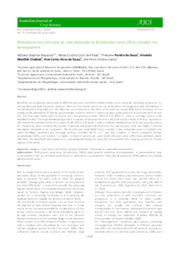Rhizobacterium Serratia sp. and phosphorus fertilization rates affect aerobic rice development.
Rhizobacterium Serratia sp. and phosphorus fertilization rates affect aerobic rice development.
Author(s): NASCENTE, A. S.; FILIPPI, M. C. C. de; SOUSA, T. P. de; CHAIBUB, A. A.; SOUZA, A. C. A. de; LANNA, A. C.
Summary: Beneficial microorganisms participate in different processes that affect transformation of soil nutrients, including phosphorus (P), making them available for plants. However, there are few studies about the use of beneficial microorganism and P fertilization in the development of aerobic rice. The objective was to determine the effect of Serratia spp. isolate BRM 32114 and doses of P at sowing on the production of biomass, gas exchange, nutrient content in leaves and grain, grain yield and its components of aerobic rice. The field experiments were conducted over two growing seasons, 2015/16 and 2016/17, under a no-tillage system in the Brazilian Cerrado. The experimental design was a complete randomized block in a factorial 4x2x2 scheme, with four replications. The treatments consisted of four P2O5 doses (0, 40, 80 and 120 kg ha-1) with or without rhizobacterium (2) in two growing seasons (2). Phosphorus rates increased the number of panicles and grain yield of aerobic rice, and the grain yield was higher in Serratia inoculation compared to no inoculation. The Serratia spp. strain BRM 32114 inserted in the production system of aerobic rice, under no-tillage, promoted gas exchange activity; enriched the K+, Ca+2 and Mg+2 content in leaves; enhanced biomass accumulation (13%), and resulted in a higher number of panicles per plant (11%) and grain yield (19%) than untreated plants. Therefore, this beneficial microorganism is a promising technology for potential incorporation into cropping systems in Tropical regions of the world.
Publication year: 2020
Types of publication: Journal article
Unit: Embrapa Rice & Beans
Observation
Some of Embrapa's publications are published as ePub files. To read them, use or download one of the following free software options to your computer or mobile device. Android: Google Play Books; IOS: iBooks; Windows and Linux: Calibre.
Access other publications
Access the Agricultural Research Database (BDPA) to consult Embrapa's full library collection and records.
Visit Embrapa Bookstore to purchase books and other publications sold by Embrapa.

